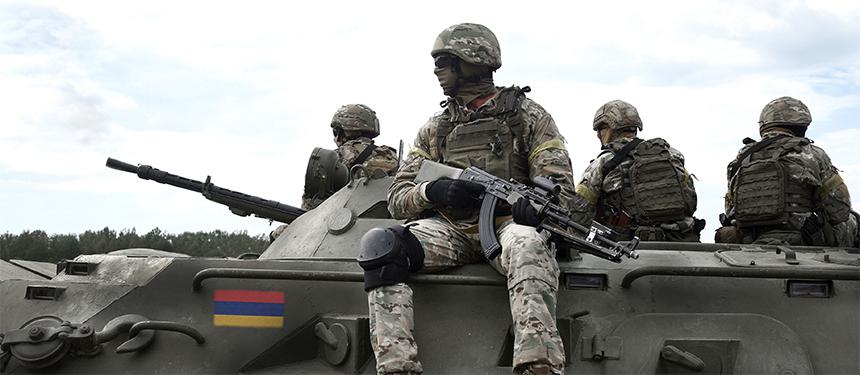Nagorno-Karabakh conflict rages on

What’s happening in Nagorno-Karabakh?
Nagorno-Karabakh is an ethnically Armenian territory that is legally part of Azerbaijan, but has been occupied by Armenia since the 1991-1994 Nagorno-Karabakh war. On 26th September, renewed fighting broke out between Armenian and Azerbaijani military forces in the disputed territory, resulting in at least 750 fatalities. Both sides have deployed aircraft, long-range missiles and artillery – Stepanakert, the de facto Armenian-controlled capital of Nagorno-Karabakh, has been struck by airstrikes daily. At least half of Stepanakert’s civilian population has been displaced. A Russian-brokered ceasefire came into effect on 10th October, but was violated almost immediately. The fighting in the region is the worst since the 1991-1994 Nagorno-Karabakh War. Armenian Prime Minister Nikol Pashinyan has accused Turkey and Azerbaijan of ethnic cleansing of Armenians in the region, while Azerbaijani President Ilham Aliyev has vowed to continue fighting until Armenian forces leave the disputed territory. Both presidents have declared martial law and mobilised military forces in their respective countries.
Why has fighting broken out now?
Both sides have blamed the other for the latest escalation, but evidence suggests an Azerbaijani offensive into the disputed territories caused the fighting. In the days leading up to 26th September, there were reports of an influx of Turkish proxy military forces into Azerbaijan, and social media servers across the country were blocked in the days prior to the offensive. This was likely an attempt to control information flows out the country and ensure government narratives were prominent. Prolonged Azerbaijani offensives across the frontline in the days immediately following 26th September further suggest a level of premeditation and coordination. The Azerbaijani government claims to have captured a number of villages in Nagorno-Karabakh, including Qaraxanbəyli, Qərvənd, Kənd Horadiz, Böyük Mərcanlı and Nüzgar.
What’s Turkey and Russia’s role?
Whenever violence has previously flared up, the so-called Minsk Group – namely France, the US and Russia - as part of the Organisation for Security and Co-Operation in Europe (OSCE), have condemned the violence and urged Armenia and Azerbaijan to return to negotiations. Iran and Turkey have typically adopted a similar position. However, this time Turkey has sent tanks, fighter jets and numerous elements of its proxy forces to Baku – including fighters from the Hamza Brigade – a rebel group that fights in north-western Syria in cooperation with the Turkish Armed Forces. Turkish President Recep Tayyip Erdogan has pledged to support Azerbaijan until the war finishes. The two countries are bound by strong ethnic, cultural and historical ties – Turkey was the first country to recognise Azerbaijan’s independence after the collapse of the Soviet Union in 1991.
By contrast, Russia has assumed a far quieter role despite its status as a security guarantor for Armenia under the Collective Security Treaty Organisation (CTSO). Russia also maintains good relations with Azerbaijan. The Russian government has instead preferred to repeat calls for a ceasefire, rather than become engaged in the conflict militarily – this is likely due to the growing number of crises within what it views as its ‘spheres of influence’, including Belarus, Kyrgyzstan and the ongoing conflict in Eastern Ukraine. Russia is also reluctant to endanger relations with Azerbaijan, which has served as an important strategic ally and reliable partner in Russia’s ongoing efforts to fight jihadism and Chechen separatism in its restive North Caucasus region.
Why does the conflict in Nagorno-Karabakh matter?
The South Caucasus region is known for its extensive oil and gas supplies. Azerbaijan is a major supplier of oil and gas to immediate neighbours Turkey and Georgia via the South Caucasus Pipeline, and is currently in the process of developing a pipeline that will supply natural gas through Albania and through the Adriatic Sea to Italy. From Italy, the gas can then be fed into European pipeline networks. This helps the European Union achieve its longer-term goal of reducing energy dependence upon Russia, as most of Europe’s natural gas is imported from Russia via Ukraine and from south-eastern Europe. A large-scale conflict could therefore severely disrupt oil and gas exports, having a knock-on effect through increased prices worldwide. Fears have also been raised that an escalation could drag Russia and Turkey into the conflict, which would increase the prospects of an all-out war between the region’s two prominent superpowers.
Will the conflict end anytime soon?
The conflict sadly shows little sign of easing. Both Armenia and Azerbaijan hold uncompromising and polarised visions for the territory; the former envisions it as part of its Christian-majority state, while Azerbaijan conceives it as having autonomy as part of its Muslim-majority state. Recent belligerent rhetoric by both leaders further constrains their ability to compromise, particularly in the context of increasingly hawkish domestic populations. These maximalist positions make negotiations and compromises almost impossible.
The involvement of Turkey in the conflict has further complicated any resolution, given Azerbaijan, backed by Turkish militants is seemingly emboldened and determined to recapture the entire territory. Growing suggestions of jihadist elements within Turkish proxies sent to Baku further complicate this effort and risk opening up a new dimension in the conflict, as the war could become portrayed as a ‘defensive jihad’ in which Azeri Muslims are helping to liberate Christian-controlled Armenian land. This dynamic would further polarise the conflict and make peace negotiations significantly more difficult.
International efforts led by the Minsk Group have not been effectively managed since the last major negotiations collapsed in 2010, with continuous failures on reaching agreements on key issues in the conflict, most prominently the status of Nagorno-Karabakh. Armenia insists on statehood for Nagorno-Karabakh, while Baku is at most prepared to offer the territory self-governance as part of Azerbaijan. The issue of settlers is also central - many Azeris in territories next to Nagorno-Karabakh were forced to flee during the 1992-1994 war, with the territory now largely occupied by Armenian settlers. Accommodating both settlers and displaced peoples while returning these areas to Azerbaijan has proved unsuccessful. Against this backdrop of international apathy, mutually exclusive positions and continued war, a possible peace deal appears further away than ever.




